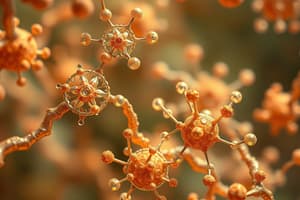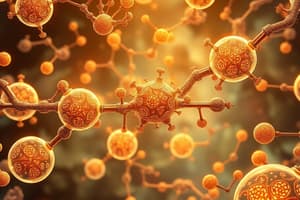Podcast
Questions and Answers
What type of biological molecules are carbohydrates primarily composed of?
What type of biological molecules are carbohydrates primarily composed of?
- Monosaccharides (correct)
- Fatty acids
- Amino acids
- Nucleotides
Which of the following correctly describes the role of enzymes?
Which of the following correctly describes the role of enzymes?
- They slow down chemical reactions.
- They increase the activation energy required for reactions.
- They accelerate chemical reactions without being consumed. (correct)
- They are consumed during the reaction.
Which of the following is NOT a type of protein structure?
Which of the following is NOT a type of protein structure?
- Quaternary
- Hexagonal (correct)
- Tertiary
- Primary
What is the primary function of lipids in biological systems?
What is the primary function of lipids in biological systems?
In metabolism, what is the process of breaking down complex molecules called?
In metabolism, what is the process of breaking down complex molecules called?
Which of the following best describes nucleic acids?
Which of the following best describes nucleic acids?
What is the role of the citric acid cycle in cellular metabolism?
What is the role of the citric acid cycle in cellular metabolism?
Which statement about the structure of proteins is accurate?
Which statement about the structure of proteins is accurate?
Which stage of cellular respiration does not require oxygen?
Which stage of cellular respiration does not require oxygen?
What is the primary role of signaling pathways in cells?
What is the primary role of signaling pathways in cells?
Which process converts the information in DNA into a usable form?
Which process converts the information in DNA into a usable form?
Which of the following is NOT a component of cell signaling pathways?
Which of the following is NOT a component of cell signaling pathways?
What is the role of buffers in biochemical solutions?
What is the role of buffers in biochemical solutions?
Flashcards
Cellular Respiration
Cellular Respiration
A cellular process that breaks down glucose to produce ATP, the cell's primary energy currency. It occurs in three stages: glycolysis, the Krebs cycle, and the electron transport chain.
Glycolysis
Glycolysis
The first stage of cellular respiration, occurring in the cytoplasm. It breaks down glucose into pyruvate, producing a small amount of ATP.
Krebs Cycle (Citric Acid Cycle)
Krebs Cycle (Citric Acid Cycle)
The second stage of cellular respiration, taking place in the mitochondria. It further breaks down pyruvate, generating ATP and reducing equivalents (NADH and FADH2).
Electron Transport Chain
Electron Transport Chain
Signup and view all the flashcards
Cell Signaling
Cell Signaling
Signup and view all the flashcards
What is Biochemistry?
What is Biochemistry?
Signup and view all the flashcards
What are carbohydrates?
What are carbohydrates?
Signup and view all the flashcards
What are lipids?
What are lipids?
Signup and view all the flashcards
What are proteins?
What are proteins?
Signup and view all the flashcards
What are nucleic acids?
What are nucleic acids?
Signup and view all the flashcards
What is metabolism?
What is metabolism?
Signup and view all the flashcards
What are enzymes?
What are enzymes?
Signup and view all the flashcards
What is Cellular Respiration?
What is Cellular Respiration?
Signup and view all the flashcards
Study Notes
Introduction to Biochemistry
- Biochemistry studies chemical processes in and related to living things.
- It spans from tiny molecules to complex biological systems.
- It integrates chemistry, physics, and biology to understand life at a molecular level.
- Key aspects include biological molecule structure/function, metabolism, and genetics.
Biological Molecules
- Carbohydrates: Polymers of simple sugars (monosaccharides).
- Crucial for energy storage and structural support (e.g., cellulose).
- Examples include glucose, fructose, and sucrose.
- Classified as monosaccharides, disaccharides, or polysaccharides.
- Lipids: Hydrophobic molecules mainly carbon and hydrogen.
- Include fats, oils, and phospholipids.
- Crucial for energy storage, insulation, and membrane structure.
- Types include saturated, unsaturated, and trans fats.
- Proteins: Complex amino acid polymers.
- Diverse functions: catalysis (enzymes), transport, structure, defense.
- Structure determined by amino acid sequence and interactions.
- Four levels of protein structure: primary, secondary, tertiary, and quaternary.
- Nucleic Acids: Deoxyribonucleic acid (DNA) and ribonucleic acid (RNA).
- Carry genetic information.
- DNA stores genetic info, RNA in protein synthesis and other processes.
- Composed of nucleotides with a sugar, phosphate, and nitrogenous base.
Metabolism
- Metabolism encompasses all chemical reactions in a living organism.
- Two main types: anabolism (synthesis) and catabolism (breakdown).
- Key pathways include glycolysis, the citric acid cycle, and oxidative phosphorylation.
- Enzymes are crucial for catalyzing metabolic reactions.
- Energy production (ATP synthesis) is central to metabolism.
Enzymes
- Biological catalysts that speed up reactions without being consumed.
- Often proteins with specific active sites for substrates.
- Enzyme activity is affected by temperature, pH, and substrate concentration.
- Lock-and-key and induced fit models explain substrate binding.
- Enzymes lower activation energy for reactions.
Cellular Respiration
- Cells break down glucose to produce ATP.
- Stages include glycolysis, Krebs cycle, and electron transport chain.
- Produces a large amount of ATP, the cell's energy currency.
- Oxygen is needed in later stages (aerobic respiration).
- Anaerobic respiration (fermentation) occurs without oxygen.
Cell Signaling
- Cells communicate via signaling molecules.
- Signaling pathways transmit information between or within cells.
- Key components include ligands, receptors, and second messengers.
- Signaling pathways control a wide range of cellular responses.
Genetics and Biochemistry
- Biochemical processes are essential for gene expression.
- DNA replication accurately copies genetic material.
- Transcription converts DNA information into RNA.
- Translation converts RNA information into proteins.
Other Key Concepts
- pH: Measures acidity or alkalinity of a solution.
- Buffers: Solutions resisting pH changes.
- Redox reactions: Involve electron transfer.
- Water: Universal solvent, essential for biochemical reactions.
- Homeostasis: Maintaining a stable internal environment through biochemical processes.
- Hormones: Signaling molecules regulating metabolic and physiological processes.
Studying That Suits You
Use AI to generate personalized quizzes and flashcards to suit your learning preferences.



